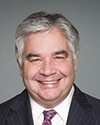Thank you very much.
It is my great pleasure to be here with you all today to talk about a very important subject: the role of museums and Canadian heritage, and especially the role of community museums.
I thank you all for this opportunity. It's the first time that I'm making such a presentation.
I thought I would just start with telling you a little bit more about me because it will give you an idea of where I come from, if you'll permit me,
Madam Chair and members of the committee.
You know my name—I'm Gail Lord. My husband and I founded Lord Cultural Resources in 1981. We're both Canadians. This is the world's largest cultural planning entity. I was honoured a year ago with the Order of Canada, which I'm very proud of. I'm also an
Officier de l'Ordre des Arts et des Lettres
from the Government of France, and I have an LLD degree from McMaster University. I feel very honoured with all this.
Our company has offices worldwide, so I think we're a great example that you can achieve, in museums and heritage, the status of international renown in a creative industry.
We've conducted more than 2,700 assignments in 57 countries, and our clients include the Louvre—and when I say the Louvre I mean the Louvre in Paris, the Louvre in Lens, and the Louvre in Abu Dhabi, which just opened.
The proudest thing for me of all these statistics—and of course they're lived experiences; they're much more than statistics—is our work in Canada. We've done more than 400 projects across this country. That means assignments of museum planning, cultural planning, and museum development in every province and territory, in museums big and small, over 36 years. We continue to work in museums big and small.
In the national capital region where you are, we've conducted more than 20 assignments alone. We're working on the rehabilitation of the Centre Block of Parliament and the visitor's centre that will be established there in due course. So we're very involved in our nation's capital. You may know that my firm won the competition to do the Holocaust Monument, which I'm inordinately proud of, which is up and operating in Ottawa near the War Museum. The proudest moment for me—I think it's good for you to know this—is the 14 years I worked on the Canadian Museum for Human Rights in Winnipeg. Our master plan was submitted to the then Prime Minister of Canada, Jean Chrétien, and was voted on unanimously by the House of Commons. This is so incredible. I think that the results in Winnipeg are very profound.
We've also worked for nine years with Pier 21 in Halifax. I just think that it speaks volumes both to the knowledge and experience that I'm privileged to have in our own country, and also worldwide. Without further ado I would like to briefly outline for you what I see as the strengths, the weaknesses, and the opportunities of the small and medium-size museum sector in Canada.
The first strength is the dedicated staff and volunteer base of our local museums and the museum communities all across Canada. There are very commendable efforts such as the Ottawa Museum Network with which we are working right now, and the Nova Scotia museum system with which we have worked over many years to support, promote, and build capacity among community museums. Community museums are so heavily reliant on volunteer support. The capacity building is a very big issue for them. The decentralization of our national museums—and I know national museums are not the subject today—is a great help because I'm not a believer in trickle-down economics, but I do believe in trickle-up and trickle-down influence. That brings tremendous expertise to each of the regions of the country in which these museums are located.
I think that combining the impetus of the national and provincial museums and their expertise with the local knowledge of the smaller museums is really a major theme.
Museums need to be seen as transformative institutions. Because they're largely voluntary, and they're so community-based, I think they're too often seen as, I don't know, “keepers of old stuff”. That's really no longer the main theme, although it's a theme of many of them. They're inspiring spaces. They're places where young people go to experience the real material history of their lives, their new lives if they're immigrants, their family lives if they're settled for a while, and their changing lives, because the lives of all Canadians are changing. So museums are really places where you can measure change, where you feel change.
So the idea of them being stale and stuffy, really nothing could be farther from the truth. They're also elevating and inspiring places, and they're places for aspiration, and again, I think we underestimate the aspirational value of community museums. In Toronto there's a new initiative called the Myseum which is to establish a Toronto museum. Toronto is actually the biggest city in the world that doesn't have a city museum. I know no one ever feels badly for Toronto, but it's a reality, and the group that's starting Myseum has private funding and they are making this museum happen as dialogues all across this huge city, and it's working. I attended an event a couple of weeks ago on the history of the ward, and there were a hundred people who showed up, and they were young. The fact that it happened to be in a brew pub probably contributed to it, but of course, in Toronto there are lots of brew pubs, and the fact is that that was a very exciting evening for people to attend.
So these are places, community museums in all their different forms, are places for what sociologists call bridging and bonding, and I think for Canada bridging and bonding is one of the most important things. We're proud of our immigration policies and rightly so. They changed fundamentally in the late 1960s and early 1970s, and I think that they're one of the most progressive aspects of our country today, and museums are places where people meet other people and create relationships, which is bridging cultures, and they're also where people bond, where they discover what they have in common. For us in Canada, especially at a time when we know that social media can be very very divisive, we have to understand that museums are inclusive and they're the opposite of divisive. They're bridging institutions. They're bonding institutions, and that would be pretty much the big idea there.
Now, what are some of the weaknesses? First of all, we have no federal museum policy.



